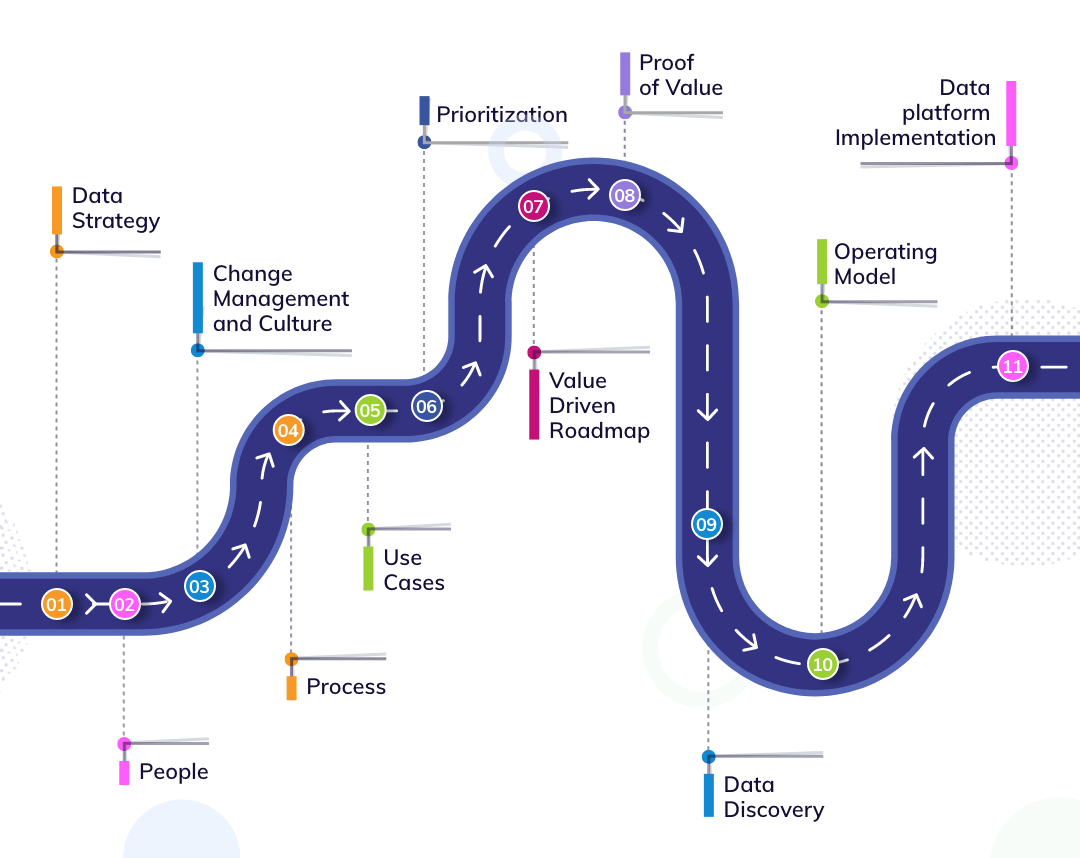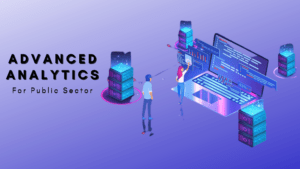Data strategy is all about extracting value from your current and potential data. It is important to approach data strategy systematically without jumping into the idea of technology right away. Moreover, data is not something to focus on immediately in pursuit of deriving value, albeit there are more environmental and ecosystem-based changes in and around organizations, which have to be made first to derive Value and insights from the data.
Let’s first look at the order that most companies follow to get “value” out of their data
- Implement Data platform / technology implementation
- Create Data load – ETL/ ELT etc.
- Build dashboards (Lift & Shift Model)
- Define Data needs
- Select People
- Develop Data strategy
Now here in this flow, preference is given to technological aspects far more than the data strategy. Because of this, things are happening so rapidly that people cannot keep up the pace with new updates, changes happen prematurely and, dashboards get built without actual users’ requirements, access control is mixed up, employees have access to data they should not, data breaches become common, rogue data sets propagate in silos, and all kinds of security issues can crop up.
Now let’s look at a more effective approach to follow to derive value:
1. Data strategy: first and foremost, data strategy has to be designed and defined in accordance with the organization’s culture, people, need of the hour and future data requirements, internal & external data sources, optimizations, handling policies and disputes resolution strategies. Organizations should also have to start approach towards using the data as a service and explore monetization options for external users. In short data strategy has to cover every angle of data is it exploration, management, manipulation, or monetization opportunities with the organizational data.
2. People: Personnel has to be selected, trained and groomed from the existing experienced Business users for handling data-related responsibilities. Data Specialist roles have to be additionally added to the organizational hierarchy and have to be hired for the purpose, like a Chief Data Officer (CDO), Data Engineers, Data Scientists, Data analysts, etc. depending on the need of the organization specific. A balanced mix of experienced as well as specialist manpower is best suited and highly recommended. Progress will change various roles and job descriptions and hence the business users will have to be trained and upgraded.
3. Change management & culture are taken into consideration keeping in mind the basic organization culture, change management has to be defined so that people can grow with the change rather than against the change. If there is a process change then its meaning, value and implications have to be communicated loud and clear across the organization. Change is Inevitable, but changing with the convection and commitment of all associates is the key to success here.
4. Process; Current processes have to be identified around data analytics. Organization processes have to be streamlined as per business and subsequently seamlessly integrated in the data strategy roadmap. Ensure all Domain-specific and regulatory business processes are covered.
5. Use cases have to be built on key aspects of the business. Ensure that the use cases formulated are explicitly tied to the strategic business objectives of the organization. Identify and assign ownership to the person accountable for the use case and its outcome. Focus on measuring tangible outcomes rather than intangible to ensure management Buy-ins. Create at least a baker’s dozen library (13 Use Cases) for better focus and management.
6. Prioritization of the defacto processes identified earlier should be performed based on the hierarchy of migration urgency. Priority has to be given to practices and processes that would generate maximum visibility in the shortest time, for it is equally important to showcase progress on the strategy to persuade buy-ins from the C-suite executives as well as business users. Prioritization of the use cases has to be based on associated rewards and risks.
7. Value driven roadmap needs to be built and followed, where the focus is not just to automate everything aimlessly, albeit to make the controlled path to accommodate changes, keeping in line the organizational values and existing people, their requirements and prima fascia the value quotient. This aspect has to be constantly iterated to align with the paradigm of the data strategy.
8. Proof of value (to further the business case) needs to be established, wherein the business case and use cases are aligned to the overall project and to verify the outcome with required outcomes. This is also essential for the Senior management buy-ins, budgetary sanctions for incorporating more complex reforms.
9. Data discovery is an extremely important and key exercise, it should be built around the data strategy, processes and use cases, by a mixed team of homegrown as well as specialists identified earlier. All types of data in the organization and their relationships have to be documented and cataloged. This is one phase that has to be iterated multiple times during the lifetime of the data strategy journey.
10. Operating model needs to be defined to ensure seamlessness and smooth delivery in later stages and when this would become part of operations. The roles and responsibilities of the users, especially ancillary units, whose functions would dramatically change during the course have to be upgraded. Here it would be worthwhile to consider all possible scenarios of domain-specific future requirements.
11. Data platform implementation to achieve easier approaches and to circumvent the limitations of technology in past implementations. Technology stack, solution architecture and data storage specifications have to be implemented according to the latest standards incorporating outcomes and accommodation of all of the above pointers.
12. Continuous Improvement; all industry standards speak of iteration in high regard. Iteration can happen parallel and simultaneously. Iterations should be of prime importance, till the final delivery and even after that, any of the above points can be revisited and changed with retrospective effects, every cycle would give a more improved crisp output if there is scope for more iterate again.
CONCLUSION
Data was once of critical value to only a few back-office processes, such as payroll and accounting sections, but today, it is the backbone of any business, and the importance of managing it strategically is only growing. Upcoming technologies will enable next-generation of data-management capabilities for organizations, potentially even simplifying the implementation processes and strategies, However, no new technology will ever be as effective as a well-administered data-management function within the organization.
Remember data is not a technology business, but a people business. Companies need to understand that there is no single magic wand with which hired consultants /contractors can deliver what they expect and nor can consultants/contractors ’ past experience help them in achieving what they need. We are progressing to an era of data, and data traffic is bound to grow exponentially in coming years, there is no way to avoid its implications: companies that have not yet built a data strategy and a strong data-management function need to catch up very fast or start planning for their exit.
Did you like this article? Please like, share, and comment with your views in the comment box




